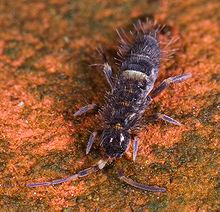Portal:Devonian
The Devonian Portal
The Devonian (/dəˈvoʊni.ən, dɛ-/ də-VOH-nee-ən, deh-) is a geologic period and system of the Paleozoic era during the Phanerozoic eon, spanning 60.3 million years from the end of the preceding Silurian period at 419.2 million years ago (Ma), to the beginning of the succeeding Carboniferous period at 358.9 Ma. It is named after Devon, South West England, where rocks from this period were first studied.
The first significant evolutionary radiation of life on land occurred during the Devonian, as free-sporing land plants (pteridophytes) began to spread across dry land, forming extensive coal forests which covered the continents. By the middle of the Devonian, several groups of vascular plants had evolved leaves and true roots, and by the end of the period the first seed-bearing plants (pteridospermatophytes) appeared. This rapid evolution and colonization process, which had begun during the Silurian, is known as the Silurian-Devonian Terrestrial Revolution. The earliest land animals, predominantly arthropods such as myriapods, arachnids and hexapods, also became well-established early in this period, after beginning their colonization of land at least from the Ordovician period.
Fishes, especially jawed fish, reached substantial diversity during this time, leading the Devonian to often be dubbed the Age of Fishes. The armored placoderms began dominating almost every known aquatic environment. In the oceans, cartilaginous fishes such as primitive sharks became more numerous than in the Silurian and Late Ordovician. Tetrapodomorphs, which include the ancestors of all four-limbed vertebrates (i.e. tetrapods), began diverging from freshwater lobe-finned fish as their more robust and muscled pectoral and pelvic fins gradually evolved into forelimbs and hindlimbs, though they were not fully established for life on land until the Late Carboniferous. (Full article...)
Selected Devonian Article

The Acadian orogeny is a long-lasting mountain building event which began in the Middle Devonian, reaching a climax in the Late Devonian. It was active for approximately 50 million years, beginning roughly around 375 million years ago (Ma), with deformational, plutonic, and metamorphic events extending into the early Mississippian. The Acadian orogeny is the third of the four orogenies that formed the Appalachian Mountains and subsequent basin. The preceding orogenies consisted of the Grenville and Taconic orogenies, which followed a rift/drift stage in the Neoproterozoic. The Acadian orogeny involved the collision of a series of Avalonian continental fragments with the Laurasian continent. Geographically, the Acadian orogeny extended from the Canadian Maritime provinces migrating in a southwesterly direction toward Alabama. However, the northern Appalachian region, from New England northeastward into Gaspé region of Canada, was the most greatly affected region by the collision.
It was roughly contemporaneous with the Bretonic phase of the Variscan orogeny of Laurussia, with metamorphic events in southwestern Texas and northern Mexico, and with the Antler orogeny of the Great Basin. (Full article...)List of selected Devonian articles
|
|---|
Selected Devonian land plant article
List of selected Devonian articles
|
|---|
Selected Devonian formation
List of selected Devonian formation articles
|
|---|
Selected Devonian fish article
Dipterus (from Greek: δίς dís, 'two' and Greek: πτερόν pteron 'wing') is an extinct genus of lungfish from the middle Devonian period of Europe and North America. In most respects, Dipterus, which was about 35 centimetres (14 in) long, closely resembled modern lungfish. Like its ancestor Dipnorhynchus, it had tooth-like plates on its palate instead of real teeth. However, unlike its modern relatives, in which the dorsal, caudal, and anal fin are fused into one, Dipterus's fins were still separated.
The genus was established by Adam Sedgwick & Roderick Murchison in the year 1828. (Full article...)Selected Devonian invertebrate
Springtails (Collembola) form the largest of the three lineages of modern hexapods that are no longer considered insects (the other two are the Protura and Diplura). Although the three orders are sometimes grouped together in a class called Entognatha because they have internal mouthparts, they do not appear to be any more closely related to one another than they are to all insects, which have external mouthparts.
Collembolans are omnivorous, free-living organisms that prefer moist conditions. They do not directly engage in the decomposition of organic matter, but contribute to it indirectly through the fragmentation of organic matter and the control of soil microbial communities. The word Collembola is from the ancient Greek κόλλα kólla "glue" and ἔμβολος émbolos "peg"; this name was given due to the existence of the collophore, which was previously thought to stick to surfaces to stabilize the creature.
Some DNA sequence studies suggest that Collembola represent a separate evolutionary line from the other Hexapoda, but others disagree; this seems to be caused by widely divergent patterns of molecular evolution among the arthropods. The adjustments of traditional taxonomic rank for springtails reflect the occasional incompatibility of traditional groupings with modern cladistics: when they were included with the insects, they were ranked as an order; as part of the Entognatha, they are ranked as a subclass. If they are considered a basal lineage of Hexapoda, they are elevated to full class status. (Full article...)List of selected Devonian invertebrates articles
|
|---|
Need help?
Do you have a question about Devonian that you can't find the answer to?
Consider asking it at the Wikipedia reference desk.
Subcategories
Related portals
Associated Wikimedia
The following Wikimedia Foundation sister projects provide more on this subject:
-
Commons
Free media repository -
Wikibooks
Free textbooks and manuals -
Wikidata
Free knowledge base -
Wikinews
Free-content news -
Wikiquote
Collection of quotations -
Wikisource
Free-content library -
Wikiversity
Free learning tools -
Wiktionary
Dictionary and thesaurus


























